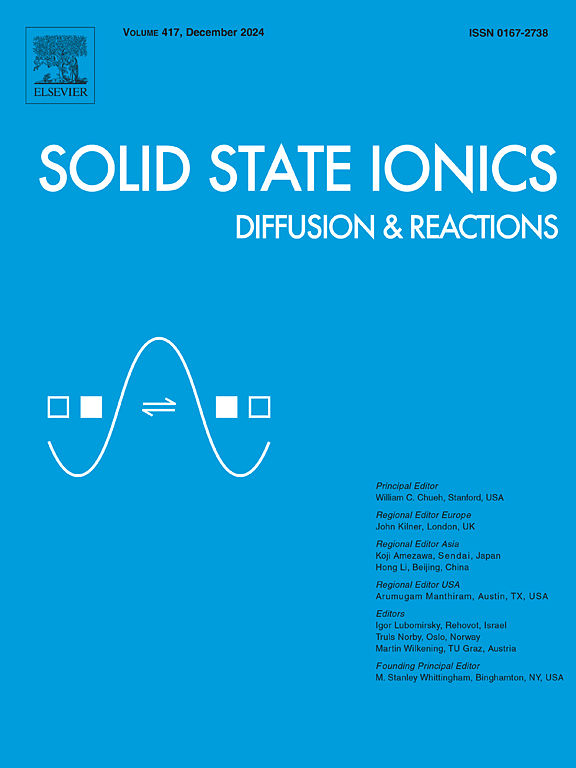New proton exchange membranes based on ionic liquid doped chitosan
IF 3
4区 材料科学
Q3 CHEMISTRY, PHYSICAL
引用次数: 0
Abstract
The development of new proton exchange membranes (PEM) for electrochemical devices have attracted researcher's attention in the pursuit for more sustainable and cost-effective technologies for clean energy production and conversion. In this work, new doped chitosan (CS) membranes were prepared by the casting method. Chitosan is an abundant, biodegradable and non-toxic material, and as a membrane, a sustainable and cheaper alternative to those perfluorinated and commonly used, such as Nafion. Three different ionic liquids were employed as dopants, ([EMIM][OTf], [EMIM][FSI] and [MIMH][HSO4]), in various concentrations and up to 50 wt% load. The new membranes were characterized by ATR-FTIR, thermogravimetry, using TGA and DSC techniques to assess their thermal properties, and by SEM, to analyse their surface morphology. Proton conduction properties of the new membranes were assessed by Electrochemical Impedance Spectroscopy (EIS). The new doped membranes showed an increase in the proton conduction compared with pristine chitosan membranes. The incorporation of ionic liquids into chitosan membranes improved their proton conductivity and thermal properties, with [EMIM][OTf] and [MIMH][HSO4] showing the most promising results. A 2-fold increment in the proton conduction was generally observed with the increase of the temperature from 30 to 60 °C. The best proton conductivity was found at 60 °C for the membrane doped with [EMIM][OTf], with a value of 47 mS.cm−1.

基于离子液体掺杂壳聚糖的新型质子交换膜
新型电化学装置质子交换膜(PEM)的开发引起了研究人员的关注,以寻求更可持续和经济的清洁能源生产和转化技术。本文采用铸造法制备了新型掺杂壳聚糖(CS)膜。壳聚糖是一种储量丰富、可生物降解且无毒的材料,作为一种膜,是一种可替代全氟化和常用的膜(如Nafion)的可持续且更便宜的替代品。采用三种不同的离子液体([EMIM][OTf], [EMIM][FSI]和[MIMH][HSO4])作为掺杂剂,浓度不同,负载高达50 wt%。利用ATR-FTIR、热重法、热重分析和差热分析技术对膜进行了表征,并通过扫描电镜分析了膜的表面形貌。利用电化学阻抗谱(EIS)评价了新膜的质子传导性能。与原始壳聚糖膜相比,新掺杂膜的质子传导能力有所提高。在壳聚糖膜中掺入离子液体可以改善壳聚糖膜的质子导电性和热性能,其中[EMIM][OTf]和[MIMH][HSO4]表现出最有希望的结果。温度从30°C升高到60°C,质子导通率一般增加2倍。在60°C时,掺杂[EMIM][OTf]的膜的质子电导率最高,为47 mS.cm−1。
本文章由计算机程序翻译,如有差异,请以英文原文为准。
求助全文
约1分钟内获得全文
求助全文
来源期刊

Solid State Ionics
物理-物理:凝聚态物理
CiteScore
6.10
自引率
3.10%
发文量
152
审稿时长
58 days
期刊介绍:
This interdisciplinary journal is devoted to the physics, chemistry and materials science of diffusion, mass transport, and reactivity of solids. The major part of each issue is devoted to articles on:
(i) physics and chemistry of defects in solids;
(ii) reactions in and on solids, e.g. intercalation, corrosion, oxidation, sintering;
(iii) ion transport measurements, mechanisms and theory;
(iv) solid state electrochemistry;
(v) ionically-electronically mixed conducting solids.
Related technological applications are also included, provided their characteristics are interpreted in terms of the basic solid state properties.
Review papers and relevant symposium proceedings are welcome.
 求助内容:
求助内容: 应助结果提醒方式:
应助结果提醒方式:


